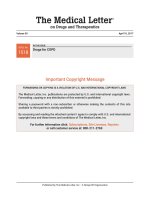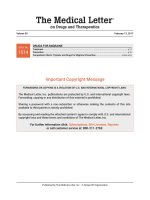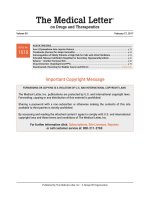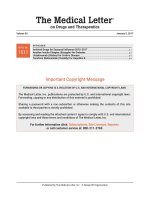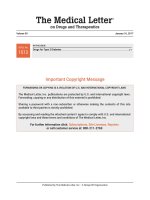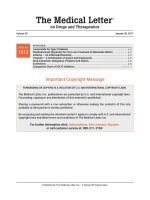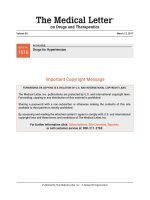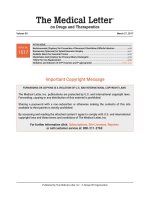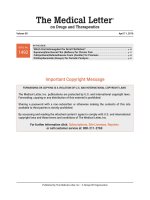The medical letter on drugs and therapeutics april 10 2017
Bạn đang xem bản rút gọn của tài liệu. Xem và tải ngay bản đầy đủ của tài liệu tại đây (214.26 KB, 9 trang )
The Medical Letter
®
on Drugs and Therapeutics
Volume 59
ISSUE
ISSUE
No.
1433
1518
April 10, 2017
IN THIS ISSUE
Drugs for COPD
Volume 56
Important Copyright Message
FORWARDING OR COPYING IS A VIOLATION OF U.S. AND INTERNATIONAL COPYRIGHT LAWS
The Medical Letter, Inc. publications are protected by U.S. and international copyright laws.
Forwarding, copying or any distribution of this material is prohibited.
Sharing a password with a non-subscriber or otherwise making the contents of this site
available to third parties is strictly prohibited.
By accessing and reading the attached content I agree to comply with U.S. and international
copyright laws and these terms and conditions of The Medical Letter, Inc.
For further information click: Subscriptions, Site Licenses, Reprints
or call customer service at: 800-211-2769
Published by The Medical Letter, Inc. • A Nonprofit Organization
The Medical Letter publications are protected by US and international copyright laws.
Forwarding, copying or any other distribution of this material is strictly prohibited.
For further information call: 800-211-2769
The Medical Letter
®
on Drugs and Therapeutics
Volume 59
April 10, 2017
Take CME Exams
ISSUE
ISSUE No.
1433
1518
IN THIS ISSUE
Drugs for COPD
Volume 56
The main goals of treatment for chronic obstructive
pulmonary disease (COPD) are to relieve symptoms,
reduce the frequency and severity of exacerbations,
and prevent disease progression. Updated guidelines for treatment of COPD have been published in
recent years.1,2
Some Recommendations for Treatment of COPD
▶ Patients with COPD should stop smoking; pharmacotherapy
can be helpful, especially with varenicline (Chantix).
▶ Patients with occasional dyspnea can use inhaled shortacting bronchodilators as needed for acute symptom relief.
▶ For patients who have moderate to severe dyspnea or
TABLES IN THIS ISSUE
Some Inhaled Bronchodilators for COPD.................................... p 58
Some Long-Acting Bronchodilator Inhalers: Ease of Use ......... p 59
Some Inhaled Corticosteroids and Other Drugs for COPD ........ p 60
Treatment of COPD ...................................................................... p 61
Inhaled Short-Acting Bronchodilators for COPD............. online only
Inhaled Long-Acting Bronchodilators for COPD ............. online only
Some Inhaled Corticosteroids for COPD.......................... online only
Correct Use of Inhalers for COPD ..................................... online only
SMOKING CESSATION — Cigarette smoking is the
primary cause of COPD in the US. Smoking cessation
offers health benefits at all stages of the disease and
can slow the decline of lung function. Counseling and
pharmacotherapy can help patients stop smoking.
Varenicline (Chantix) appears to be the most effective
drug for treatment of tobacco dependence. Nicotine
replacement therapy and bupropion (Zyban, and
others) are also effective.3 Use of ≥2 medications has
been more effective than monotherapy.4,5
SHORT-ACTING BRONCHODILATORS — For patients
with occasional dyspnea, an inhaled short-acting
bronchodilator can provide acute relief. Short-acting
drugs, which include inhaled beta2-agonists such as
albuterol and the antimuscarinic (anticholinergic)
ipratropium, can relieve symptoms and improve FEV1
(forced expiratory volume in one second). Shortacting beta2-agonists have a more rapid onset of
action than ipratropium, but ipratropium has a longer
duration of action (6-8 hrs vs ~4 hrs).
Combining a short-acting beta2-agonist with
ipratropium is more effective than either drug alone.6
The combination of ipratropium and albuterol is
available in a single inhaler (see Table 1).
▶
▶
▶
▶
▶
symptoms, or who are at increased risk of exacerbations,
regular treatment with an inhaled long-acting bronchodilator
(an antimuscarinic or a beta2-agonist) can relieve symptoms,
improve lung function, and reduce the frequency of
exacerbations.
An inhaled long-acting beta2-agonist plus an inhaled longacting antimuscarinic can be used in patients with moderate
to severe dyspnea or symptoms who are at increased risk
for exacerbations and in those inadequately controlled on
monotherapy.
Addition of an inhaled corticosteroid is recommended
for patients with moderate to severe COPD who
experience frequent exacerbations despite treatment with
bronchodilators.
All patients should be assessed for proper inhalation technique.
Oxygen therapy can improve survival in patients with
severe hypoxemia.
Pulmonary rehabilitation should be considered for all patients.
Regular use of an inhaled short-acting bronchodilator
is not recommended for treatment of COPD. Patients
on maintenance treatment for COPD should have
a short-acting bronchodilator available for use as
needed for acute relief.
INHALED LONG-ACTING BRONCHODILATORS —
Regular treatment with an inhaled long-acting
bronchodilator (either a beta2-agonist or an
antimuscarinic agent) is recommended for patients
who have moderate to severe dyspnea or symptoms
or who are at increased risk of exacerbations.
Long-acting antimuscarinic agents (LAMAs; also
called long-acting anticholinergics) may be more
effective than long-acting beta2-agonists (LABAs) in
preventing exacerbations in patients with moderate
to very severe COPD.7,8 In patients with less severe
COPD, there is no strong evidence supporting the use
of one over the other.9,10
57
Published by The Medical Letter, Inc. • A Nonprofit Organization
The Medical Letter
April 10, 2017
Vol. 59 (1518)
®
Table 1. Some Inhaled Bronchodilators for COPD
Drug
Some Available
Formulations
Delivery Device1
Usual
Adult Dosage
Cost2
17 mcg/inh
HFA MDI (200 inh/unit)
2 inh qid PRN
$332.70
200 mcg/mL soln
Nebulizer3
500 mcg qid PRN
90 mcg/inh
HFA MDI (605 or 200 inh/unit) 90-180 mcg q4-6h PRN
90 mcg/inh
0.63, 1.25, 2.5 mg/
3 mL soln
DPI (200 inh/unit)
Nebulizer3
90-180 mcg q4-6h PRN
1.25-5 mg q4-8h PRN
45 mcg/inh
0.31, 0.63, 1.25 mg/
3 mL soln
HFA MDI (80, 200 inh/unit)
Nebulizer3
90 mcg q4-6h PRN
0.63-1.25 mg tid PRN
68.20
855.00
439.90
344.907
Inhaled Short-Acting Antimuscarinic
Ipratropium – Atrovent HFA
(Boehringer Ingelheim)
generic – single-dose vials
18.104
Inhaled Short-Acting Beta2-Agonists
Albuterol – ProAir HFA (Teva)
Proventil HFA (Merck)
Ventolin HFA (GSK)
ProAir Respiclick (Teva)
generic
Levalbuterol –
Xopenex HFA (Sunovion)
Xopenex (Akorn)
generic
56.20
75.40
52.20
53.00
21.306
Inhaled Short-Acting Beta2-Agonist/Short-Acting Antimuscarinic Combination
Albuterol/ipratropium –
Combivent Respimat
(Boehringer Ingelheim)
generic
100 mcg/20 mcg/inh
ISI (120 inh/unit)
1 inh qid PRN
2.5 mg/0.5 mg/3 mL soln
Nebulizer3
2.5 mg/0.5 mg qid PRN
73.107
Inhaled Long-Acting Beta2-Agonists (LABAs)
Arformoterol – Brovana (Sunovion)
15 mcg/2 mL soln
Nebulizer3
15 mcg bid
871.20
Indacaterol – Arcapta Neohaler
(Sunovion)
75 mcg/cap
DPI (30 inh/unit)
1 inh once/d
213.60
Olodaterol – Striverdi Respimat
(Boehringer Ingelheim)
2.5 mcg/inh
ISI (60 inh/unit)
2 inh once/d
181.60
Salmeterol – Serevent Diskus (GSK)
50 mcg/blister
DPI (28, 60 inh/unit)
1 inh bid
351.60
Formoterol – Perforomist (Mylan)
20 mcg/2 mL soln
Nebulizer3
20 mcg bid
838.80
Inhaled Long-Acting Antimuscarinic Agents (LAMAs)8
Aclidinium – Tudorza Pressair
(AstraZeneca)
400 mcg/inh
DPI (30, 60 inh/unit)
1 inh bid
322.20
Glycopyrrolate – Seebri Neohaler
(Sunovion)
15.6 mcg/cap
DPI (6, 60 inh/unit)
1 inh bid
394.20
Tiotropium –
Spiriva Handihaler (Boehringer Ingelheim) 18 mcg/cap
Spiriva Respimat
2.5 mcg/inh
DPI (5, 30, 90 inh/unit)
ISI (60 inh/unit)
18 mcg9 once/d
2 inh once/d
368.20
368.20
Umeclidinium – Incruse Ellipta (GSK)
DPI (7, 30 inh/unit)
1 inh once/d
324.10
62.5 mcg/inh
Inhaled Long-Acting Antimuscarinic Agents/Long-Acting Beta2-Agonist Combinations (LAMA/LABA Combinations)
Glycopyrrolate/formoterol –
Bevespi Aerosphere (AstraZeneca)
9 mcg/4.8 mcg/inh
HFA MDI (120 inh/unit)
2 inh bid
334.60
Glycopyrrolate/indacaterol –
Utibron Neohaler (Sunovion)
15.6 mcg/27.5 mcg/cap
DPI (60 inh/unit)
1 inh bid
340.20
Tiotropium/olodaterol –
Stiolto Respimat (Boehringer Ingelheim)
2.5 mcg/2.5 mcg/inh
ISI (60 inh/unit)
2 inh once/d
340.90
Umeclidinium/vilanterol –
Anoro Ellipta (GSK)
62.5 mcg/25 mcg/inh
DPI (7, 30 inh/unit)
1 inh once/d
340.90
DPI = dry powder inhaler; ER = extended-release; HFA = hydrofluoroalkane; inh = inhalation; ISI = inhalation spray inhaler; MDI = metered-dose inhaler
1. All patients should be assessed for proper inhalation technique.
2. Approximate WAC for 30 days’ treatment at the lowest recommended adult dosage. For short-acting beta2-agonists and Atrovent HFA, cost is for 200 inhalations. WAC = wholesaler acquisition cost or manufacturer’s published price to wholesalers; WAC represents a published catalogue or list price and may not
represent an actual transactional price. Source: AnalySource® Monthly. March 5, 2017. Reprinted with permission by First Databank, Inc. All rights reserved.
©2017. www.fdbhealth.com/policies/drug-pricing-policy.
3. Nebulized solutions may be used for very young, very old, and other patients unable to use handheld inhalers. More time is required to administer the drug
and the device may not be portable. Nebulizers and nebulized drugs may be covered as durable medical equipment (DME) under Medicare part B.
4. Cost for 100 doses.
5. Only Ventolin HFA is available in an inhaler containing 60 inh/unit.
6. Cost for 100 2.5-mg doses.
7. Cost for 120 doses.
8. Also called inhaled long-acting anticholinergics.
9. Contents of one capsule; two inhalations of the powder are required to deliver the full dose.
58
The Medical Letter
®
LABAs can provide sustained bronchodilation for at
least 12 hours. They have been shown to improve
lung function and quality of life, and to reduce the
frequency of exacerbations in patients with COPD.11
Several inhaled LABAs are available alone or in fixeddose combinations with other agents for treatment of
COPD in the US (see Tables 1 and 3).
Inhaled beta2-agonists can cause tachycardia, palpitations, prolongation of the QT interval, hypokalemia,
skeletal muscle tremors and cramping, headache,
insomnia, and increases in serum glucose concentrations.
Unstable angina and myocardial infarction have been
reported. Tolerance can develop with continued use.
All LABAs in the US include a boxed warning about an
increased risk of asthma-related death; there is no
evidence to date that patients with COPD are at risk.
Four inhaled LAMAs are available alone or in combination with other agents for the treatment of COPD (see
Table 1). Tiotropium, the longest available and best
studied LAMA, has been shown to improve lung function
and reduce exacerbation and hospitalization rates, but
it may not reduce the rate of lung function decline.12,13
The other three LAMAs are generally considered similar
in safety and efficacy to tiotropium.14-16
Inhaled antimuscarinics have limited systemic
absorption. They commonly cause dry mouth.
Pharyngeal irritation, urinary retention, and increases
in intraocular pressure may occur; antimuscarinic
inhalers should be used with caution in patients with
narrow-angle glaucoma and in those with symptomatic
prostatic hypertrophy or bladder neck obstruction.
Long-Acting
Bronchodilator
Combinations
–
Combining a LAMA with a LABA can improve lung
function and reduce symptoms, and may decrease
exacerbation rates in patients with COPD. Dual
bronchodilator therapy is recommended for patients
who have moderate to severe dyspnea or symptoms
and are at increased risk for exacerbations and for
those with persistent symptoms or exacerbations
despite use of a single long-acting bronchodilator.17,18
Four fixed-dose combinations of a LAMA and a LABA
have been approved by the FDA (see Table 1).
INHALED CORTICOSTEROIDS (ICSs) — ICSs do not slow
the progression of COPD or reduce mortality.19 They are
less effective than inhaled long-acting bronchodilators
for treatment of COPD and should not be used as
monotherapy. Use of an ICS in addition to a long-acting
bronchodilator can improve lung function and reduce
exacerbations.20 Addition of an ICS is recommended
Vol. 59 (1518)
April 10, 2017
Table 2. Some Long-Acting Bronchodilator Inhalers:
Ease of Use
Aerosphere Inhaler
Bevespi Aerosphere (glycopyrrolate/formoterol)
▶ Metered-dose inhaler; requires coordination of inhalation with
hand-actuation; drug delivery is not dependent on strength of
breath intake
▶ Easy to assemble; requires priming
▶ Indicator shows approximately how many doses are left
▶ Twice-daily dosing
Ellipta Inhalers
Anoro Ellipta (umeclidinium/vilanterol), Breo Ellipta (fluticasone
furoate/vilanterol), Incruse Ellipta (umeclidinium)
▶ Dry powder inhaler; drug delivery to lungs is dependent upon
ability to perform a rapid, deep inhalation
▶ No assembly or priming required
▶ Indicator shows how many doses are left
▶ Doses may be wasted if inhaler is opened/closed accidentally
▶ Once-daily dosing
Respimat Inhalers
Spiriva Respimat (tiotropium), Striverdi Respimat (olodaterol),
Stiolto Respimat (tiotropium/olodaterol)
▶ Inhalation spray inhaler; drug delivery to lungs is not dependent
on strength of breath intake
▶ Assembly may be difficult for some patients
▶ Indicator shows approximately how many doses are left
▶ Once-daily dosing
Neohaler Inhalers
Arcapta Neohaler (indacaterol), Seebri Neohaler (glycopyrrolate),
Utibron Neohaler (glycopyrrolate/indacaterol)
▶ Dry powder inhaler; drug delivery to lungs is dependent upon
ability to perform a rapid, deep inhalation
▶ Removal of the capsule from the foil pack and insertion of the
capsule into the inhaler may be difficult for some patients
▶ Transparent capsules may be helpful in determining if the full
dose was inhaled
▶ Once-daily dosing (Arcapta); twice-daily dosing (Utibron, Seebri)
Pressair Inhaler
Tudorza Pressair (aclidinium)
▶ Dry powder inhaler; drug delivery to lungs is dependent upon
ability to perform a rapid, deep inhalation
▶ No assembly required
▶ Twice-daily dosing
Handihaler Inhaler
Spiriva Handihaler (tiotropium)
▶ Dry powder inhaler; drug delivery to lungs is dependent upon
ability to perform a rapid, deep inhalation
▶ Inserting the capsules into the device may be difficult for some
patients
▶ Once-daily dosing
Diskus Inhalers
Advair Diskus (fluticasone propionate/salmeterol), Serevent
Diskus (salmeterol)
▶ Dry powder inhaler; drug delivery to lungs is dependent upon
ability to perform a rapid, deep inhalation
▶ Indicator shows how many doses are left
▶ Twice-daily dosing
for patients with moderate to very severe COPD who
continue to have exacerbations while receiving longacting bronchodilators. Various combinations of ICSs
and LABAs are available (see Table 3).
Adverse Effects – Local effects of ICSs on the mouth
and pharynx include candidiasis and dysphonia.
59
The Medical Letter
April 10, 2017
Vol. 59 (1518)
®
Table 3. Some Inhaled Corticosteroids and Other Drugs for COPD
Drug
Some Available
Formulations
Delivery Device1
Usual
Adult Dosage
Cost2
Inhaled Corticosteroids (ICSs)3
Beclomethasone dipropionate –
QVAR (Teva)
40, 80 mcg/inh
HFA MDI (120 inh/unit)
40-320 mcg bid
$156.70
Budesonide4 – Pulmicort Flexhaler
(AstraZeneca)
90, 180 mcg/inh
DPI (60, 120 inh/unit)
180-720 mcg bid
216.50
Ciclesonide – Alvesco (Sunovion)
80, 160 mcg/inh
HFA MDI (60 inh/unit)
80-320 mcg bid
228.90
Flunisolide – Aerospan HFA (Meda)
80 mcg/inh
HFA MDI (60, 120 inh/unit)
160-320 mcg bid
196.10
Fluticasone furoate –
Arnuity Ellipta (GSK)
100, 200 mcg/inh
DPI (14, 30 inh/unit)
100-200 mcg once/d
159.00
Fluticasone propionate –
Flovent Diskus (GSK)
Flovent HFA
ArmonAir Respiclick (Teva)
50, 100, 250 mcg/blister
44, 110, 220 mcg/inh
55, 113, 232 mcg/inh
DPI (28, 60 inh/unit)
HFA MDI (120 inh/unit)
DPI (60 inh/unit)
100-1000 mcg bid
88-880 mcg bid
55-232 mcg bid
171.40
171.40
N.A.
100, 200 mcg/inh
110, 220 mcg/inh
HFA MDI (120 inh/unit)
DPI (30, 60, 120 inh/unit)
200-400 mcg bid
220-880 mcg once/d in
evening or 220 mcg bid
178.80
179.00
Mometasone furoate –
Asmanex HFA (Merck)
Asmanex Twisthaler
(Merck)
Inhaled Corticosteroid/Long-Acting Beta2-Agonist Combinations (ICS/LABA Combinations)
Fluticasone propionate/salmeterol –
Advair Diskus5 (GSK)
100, 250, 500 mcg/50 mcg/
DPI (28, 60 inh/unit)
blister
45, 115, 230 mcg/21 mcg/inh HFA MDI (60, 120 inh/unit)
55, 113, 232 mcg/14 mcg/inh DPI (60 inh/unit)
250/50 mcg bid
361.40
2 inh bid
1 inh bid
290.90
N.A
Fluticasone furoate/vilanterol –
Breo Ellipta6 (GSK)
100, 200 mcg/25 mcg/inh
DPI (14, 30 inh/unit)
1 inh once/d
321.70
Budesonide/formoterol –
Symbicort7 (AstraZeneca)
80, 160 mcg/4.5 mcg/inh
HFA MDI (60, 120 inh/unit)
2 inh bid
308.70
500 mcg tabs
none
500 mcg PO once/d
199.00
100, 200, 300, 400, 450,
600 mg ER tabs;
80 mg/15 mL soln
80 mg/15 mL soln
none
300-600 mg PO once/d
or divided bid
Advair HFA3
AirDuo Respiclick3 (Teva)
Phosphodiesterase-4 (PDE4) Inhibitor
Roflumilast – Daliresp (AstraZeneca)
Methylxanthine
Theophylline8,9 – generic
Elixophyllin (Nostrum Labs)
Theo-24 (Auxilium)
Theochron (Caraco)
100, 200, 300, 400 mg
ER caps
100, 200, 300 mg ER tabs
15.90
300-600 mg/d PO
1261.30
divided tid-qid
300-600 mg PO once/d10
86.50
300-600 mg PO once/d
15.10
DPI = dry powder inhaler; ER = extended-release; HFA = hydrofluoroalkane; inh = inhalation; ISI = inhalation spray inhaler; MDI = metered-dose inhaler; NA = cost
not available
1. All patients should be assessed for proper inhalation technique.
2. Approximate WAC for 30 days’ treatment at the lowest usual adult dosage. WAC = wholesaler acquisition cost or manufacturer’s published price to wholesalers; WAC represents a published catalogue or list price and may not represent an actual transactional price. Source: AnalySource® Monthly. March 5, 2017.
Reprinted with permission by First Databank, Inc. All rights reserved. ©2017. www.fdbhealth.com/policies/drug-pricing-policy.
3. Not FDA-approved for treatment of COPD. Inhaled corticosteroid monotherapy is not recommended for treatment of COPD.
4. Budesonide is also available as a suspension for nebulization (Pulmicort Respules, and generics) that is FDA-approved only for treatment of asthma in
children 1-8 years old.
5. Only the 250/50 mcg dose is FDA-approved for use in COPD.
6. Only the 100/25 mcg dose is FDA-approved for use in COPD.
7. Only the 160/4.5 mcg dose is FDA-approved for use in COPD.
8. Extended-release formulations may not be interchangeable.
9. Periodic monitoring is recommended to maintain peak serum concentrations between 8 and 12 mcg/mL.
10. Theo-24 should not be taken <1 hr before a high-fat content meal; the entire 24-hour dose can be released in a 4-hour period, resulting in toxicity.
Systemic absorption of ICSs has been associated
with skin bruising, cataracts, reduced bone mineral
density, and an increased risk of fractures. Use of ICSs
in patients with COPD is associated with an increased
risk of pneumonia.21
ICS Withdrawal – In one study, 2485 patients with
COPD on triple therapy with tiotropium, salmeterol,
and fluticasone propionate were randomized to
either continue triple therapy or taper the ICS over
60
12 weeks. The time to the first moderate or severe
exacerbation within 12 months was similar in both
groups, but a statistically significant decrease in
trough FEV1 occurred in the corticosteroid taper
group; the clinical significance is unclear.22 A posthoc analysis found that the risk of exacerbation was
higher in the corticosteroid taper group compared
to the continuation group in patients who had blood
eosinophil levels ≥300 cells/mcL at baseline.23
The Medical Letter
®
Vol. 59 (1518)
April 10, 2017
LABA/LAMA vs ICS/LABA — In patients who are at
increased risk of exacerbations, the combination of a
LABA and a LAMA appears to be more effective than
an ICS/LABA combination in reducing exacerbations.24
In a 52-week study comparing the combination of
glycopyrronium and indacaterol with fluticasone and
salmeterol, patients who received the LAMA/LABA
combination had 11% fewer exacerbations and a longer
time to the first exacerbation than those receiving the ICS/
LABA combination. The rates of mortality and adverse
effects were similar between the two treatments.25
Table 4. Treatment of COPD1-3
TRIPLE-THERAPY REGIMENS — Some studies have
found that adding a LAMA to a LABA/ICS regimen
can reduce exacerbations and improve lung function,
symptoms, and quality of life.26-29 Whether adding an
ICS to a LABA/LAMA combination provides similar
benefits remains to be established.
Occasional Dyspnea or Few Symptoms; ≥1 exacerbation5
THEOPHYLLINE — Theophylline can be tried in
patients with persistent symptoms despite treatment
with inhaled triple-therapy. Its primary mechanism of
action is bronchodilation; at low concentrations, it may
have anti-inflammatory effects.30 Theophylline has
a narrow therapeutic index; monitoring is warranted
periodically to maintain peak serum concentrations
between 8 and 12 mcg/mL.
Adverse Effects – Dose-related adverse effects of
theophylline include nausea, nervousness, headache,
and insomnia. Vomiting, hypokalemia, hyperglycemia,
tachycardia, cardiac arrhythmias, tremors, neuromuscular irritability, and seizures can occur at
supratherapeutic serum concentrations. Theophylline
is metabolized hepatically, primarily by CYP1A2 and
CYP3A4; any drug that inhibits or induces these enzymes can affect theophylline serum concentrations.31
ROFLUMILAST — Roflumilast (Daliresp) is an oral
phosphodiesterase-4 (PDE4) inhibitor approved for
use in patients with severe COPD associated with
chronic bronchitis and a history of exacerbations. It
reduces inflammation by increasing intracellular levels
of cAMP; it does not cause bronchodilation.32 Oncedaily treatment can modestly improve lung function
and reduce the frequency of exacerbations, but it does
not appear to improve symptoms or quality of life.33,34
Common adverse effects include nausea and diarrhea.
Significant weight loss and changes in mood and
behavior have been reported.
AZITHROMYCIN — Macrolide antibiotics have antiinflammatory effects. Once-daily or three times a
week off-label use of azithromycin (Zithromax, and
Occasional Dyspnea or Few Symptoms; ≤1 exacerbation4
Inhaled ipratropium as needed
or Inhaled short-acting beta2-agonist
as needed
or LAMA
or LABA
Moderate to Severe Dyspnea or Symptoms; ≤1 exacerbation4
Initial
LAMA
or LABA
Persistent or
Severe Symptoms
Initial
LAMA + LABA
LAMA (preferred)
or LABA
Further
Exacerbations
LAMA + LABA (preferred)
or LABA + ICS
Moderate to Severe Dyspnea or Symptoms; ≥1 exacerbation5
Initial
Further
Exacerbations
LABA + LAMA
ICS + LABA + LAMA
or ICS + LABA6
or ICS + LABA + LAMA + roflumilast7
or ICS + LABA + LAMA + azithromycin8
ICS = inhaled corticosteroid; LABA = inhaled long-acting beta2-agonist;
LAMA = inhaled long-acting antimuscarinic agent
1. Adapted from the Global Strategy for the Diagnosis, Management, and
Prevention of COPD, Global Initiative for Chronic Obstructive Pulmonary
Disease (GOLD) 2017. Available at: . Accessed March
30, 2017. Dyspnea and symptoms should be assessed using mMRC
(Modified British Medical Research Council) and CAT (COPD Assessment
Test), respectively.
2. Short-acting anticholinergics and beta2-agonists can be added to any
regimen for acute relief.
3. Theophylline may be used if other long-acting bronchodilators are unavailable or unaffordable.
4. Exacerbation that did not lead to hospital admission.
5. ≥1 exacerbation leading to hospital admission or ≥2 exacerbations.
6. An ICS/LABA combination may be considered a first choice for patients with
asthma/COPD overlap or high blood eosinophil levels.
7. In patients with FEV1 <50% predicted and chronic bronchitis.
8. Or another macrolide. Consider use in former smokers.
generics) has been shown to reduce the risk of an
exacerbation over one year and improve quality of life
in patients with COPD at increased risk of exacerbation,
but use of the drug has been associated with hearing
loss and development of antimicrobial resistance.35,36
Efficacy and safety data beyond one year of use are
not available.
OXYGEN THERAPY — For patients with severe
hypoxemia, use of long-term supplemental oxygen
therapy has been shown to increase survival and may
improve quality of life.37 In a recent study, long-term
oxygen therapy did not lead to reduced mortality or
longer time to first hospitalization in patients with mild
to moderate hypoxemia.38
PULMONARY REHABILITATION — The benefits of
pulmonary rehabilitation programs for patients with
COPD are well established. Pulmonary rehabilitation
can improve dyspnea, functional capacity, and quality
of life, and reduce the number of hospitalizations.39 ■
61
The Medical Letter
®
1. GOLD 2017 global strategy for the diagnosis, management and
prevention of COPD. Available at www.goldcopd.org. Accessed
March 30, 2017.
2. A Qaseem et al. Diagnosis and management of stable chronic
obstructive pulmonary disease: a clinical practice guideline
update from the American College of Physicians, American
College of Chest Physicians, American Thoracic Society, and
European Respiratory Society. Ann Intern Med 2011; 155:179.
3. Drugs for tobacco dependence. Med Lett Drugs Ther 2016;
58:27.
4. CF Koegelenberg et al. Efficacy of varenicline combined with
nicotine replacement therapy vs varenicline alone for smoking
cessation: a randomized clinical trial. JAMA 2014; 312:155.
5. JO Ebbert et al. Combination varenicline and bupropion SR for
tobacco-dependence treatment in cigarette smokers: a randomized trial. JAMA 2014; 311:155.
6. J Nichols. Combination inhaled bronchodilator therapy in the
management of chronic obstructive pulmonary disease. Pharmacotherapy 2007; 27:447.
7. C Vogelmeier et al. Tiotropium versus salmeterol for the prevention of exacerbations of COPD. N Engl J Med 2011; 364:
1093.
8. ML Decramer et al. Once-daily indacaterol versus tiotropium
for patients with severe chronic obstructive pulmonary disease
(INVIGORATE): a randomised, blinded, parallel-group study.
Lancet Respir Med 2013; 1:524.
9. A Gershon et al. Comparison of inhaled long-acting ß-agonist
and anticholinergic effectiveness in older patients with chronic
obstructive pulmonary disease: a cohort study. Ann Intern Med
2011; 154; 583.
10. JA Wedzicha. Choice of bronchodilator therapy for patients
with COPD. N Engl J Med 2011; 364: 1167.
11. KM Kew et al. Long-acting beta2-agonists for chronic obstructive pulmonary disease. Cochrane Database Syst Rev 2013;
10:CD010177.
12. DP Tashkin et al. A 4-year trial of tiotropium in chronic obstructive pulmonary disease. N Engl J Med 2008; 359:1543.
13. M Decramer et. al. Effect of tiotropium on outcomes in patients
with moderate chronic obstructive pulmonary disease (UPLIFT): a prespecified subgroup analysis of a randomised controlled trial. Lancet 2009; 374:1171.
14. Aclidinium bromide (Tudorza Pressair) for COPD. Med Lett
Drugs Ther 2012; 54:99.
15. Seebri Neohaler and Utibron Neohaler for COPD. Med Lett
Drugs Ther 2016; 58:39.
16. Umeclidinium (Incruse Ellipta) for COPD. Med Lett Drugs Ther
2015; 57:63.
17. T van der Molen and M Cazzola. Beyond lung function in COPD
management: effectiveness of LABA/LAMA combination therapy on patient-centred outcomes. Prim Care Respir J 2012;
21:101.
18. HA Farne and CJ Cates. Long-acting beta2-agonist in addition
to tiotropium versus either tiotropium or long-acting beta2agonist alone for chronic obstructive pulmonary disease. Cochrane Database Syst Rev 2015; 10:CD008989.
19. PM Calverley et al. Salmeterol and fluticasone propionate and
survival in chronic obstructive pulmonary disease. N Engl J
Med 2007; 356:775.
20. LJ Nannini et al. Combined corticosteroid and long-acting
beta(2)-agonist in one inhaler versus long-acting beta(2)agonists for chronic obstructive pulmonary disease. Cochrane
Database Syst Rev 2012; 9:CD006829.
21. JB Morjaria et al. Inhaled corticosteroid use and the risk of
pneumonia and COPD exacerbations in the UPLIFT study. Lung
2017 March 3 (epub).
22. H Magnussen et al. Withdrawal of inhaled glucocorticoids and
exacerbations of COPD. N Engl J Med 2014; 371:1285.
62
Vol. 59 (1518)
April 10, 2017
23. H Watz et al. Blood eosinophil count and exacerbations in severe chronic obstructive pulmonary disease after withdrawal
of inhaled corticosteroids: a post-hoc analysis of the WISDOM
trial. Lancet Respir Med 2016; 4:390.
24. N Horita et al. Long-acting muscarinic antagonist (LAMA) plus
long-acting beta-agonist (LABA) versus LABA plus inhaled corticosteroid (ICS) for stable chronic obstructive pulmonary disease (COPD). Cochrane Database Syst Rev 2017; 10:CD012066.
25. JA Wedzicha et al. Indacaterol-glycopyrronium versus salmeterol-fluticasone for COPD. N Engl J Med 2016; 374:2222.
26. PA Frith et al. Glycopyrronium once-daily significantly improves
lung function and health status when combined with salmeterol/fluticasone in patients with COPD: the GLISTEN study, a
randomised controlled trial. Thorax 2015; 70:519.
27. D Singh et al. Superiority of “triple” therapy with salmeterol/
fluticasone propionate and tiotropium bromide versus individual components in moderate to severe COPD. Thorax 2008;
63:592.
28. TM Siler et al. Efficacy and safety of umeclidinium added to
fluticasone propionate/salmeterol in patients with COPD: results of two randomized, double-blind studies. COPD 2016;
13:1.
29. D Singh et al. Single inhaler triple therapy versus inhaled corticosteroid plus long-acting β2-agonist therapy for chronic obstructive pulmonary disease (TRILOGY): a double-blind, parallel
group, randomised controlled trial. Lancet 2016; 388:963.
30. PJ Barnes. Theophylline. Am J Respir Crit Care Med 2013;
188:901.
31. Inhibitors and inducers of CYP enzymes and P-glycoprotein.
Med Lett Drugs Ther 2017; 59:e56. Updated March 2, 2017.
Available at: www.medicalletter.org/TML-article-1517f. Accessed March 30, 2017.
32. Roflumilast (Daliresp) for COPD. Med Lett Drugs Ther 2011;
53:59.
33. PM Calverley et al. Roflumilast in symptomatic chronic obstructive pulmonary disease: two randomised clinical trials.
Lancet 2009; 374:685.
34. J Chong et al. Phosphodiesterase 4 inhibitors for chronic obstructive pulmonary disease. Cochrane Database Syst Rev
2013; 11:CD002309.
35. RK Albert et al. Azithromycin for prevention of exacerbations of
COPD. N Engl J Med 2011; 365:689.
36. S Uzun et al. Azithromycin maintenance treatment in patients
with frequent exacerbations of chronic obstructive pulmonary
disease (COLUMBUS): a randomised, double-blind, placebocontrolled trial. Lancet Respir Med 2014; 2:361.
37. JK Stoller et al. Oxygen therapy for patients with COPD: current evidence and the long-term oxygen treatment trial. CHEST
2010; 138:179.
38. Long-Term Oxygen Treatment Trial Research Group et al. A
randomized trial of long-term oxygen for COPD with moderate
desaturation. N Engl J Med 2016; 375:1617.
39. B McCarthy et al. Pulmonary rehabilitation for chronic obstructive pulmonary disease. Cochrane Database Syst Rev 2015;
2:CD003793.
Online Only Tables
Inhaled Short-Acting Bronchodilators for COPD
/>Inhaled Long-Acting Bronchodilators for COPD
/>Some Inhaled Corticosteroids for COPD
/>Correct Use of Inhalers for COPD
/>
The Medical Letter
®
Continuing Medical Education Program
medicalletter.org/cme-program
Earn Up To 52 Credits Per Year
Choose CME from The Medical Letter in the format that’s right for you!
▶ Comprehensive Exam – Available online or in print to Medical Letter subscribers, this 130 question exam enables you to earn 26 credits immediately
upon successful completion of the test. A score of 70% or greater is required to pass the exam. Our comprehensive exams allow you to test at your
own pace in the comfort of your home or office. Comprehensive exams are offered every January and July enabling you to earn up to 52 credits per
year. $49/exam.
▶ Free Individual Exams – Free to active subscribers of The Medical Letter. Answer 10 questions per issue and submit answers online. Earn 2 credits/exam.
A score of 70% or greater is required to pass the exam.
▶ Paid Individual Exams – Available to non-subscribers. Answer 10 questions per issue and submit answers online. Earn 2 credits/exam. $12/exam.
A score of 70% or greater is required to pass the exam.
ACCREDITATION INFORMATION:
ACCME: The Medical Letter is accredited by the Accreditation Council for Continuing Medical Education to provide continuing medical education for physicians. The Medical
Letter designates this enduring material for a maximum of 2 AMA PRA Category 1 Credits™. Physicians should claim only the credit commensurate with the extent of their
participation in the activity. This CME activity was planned and produced in accordance with the ACCME Essentials and Policies.
ABIM MOC: Successful completion of this CME activity, which includes participation in the evaluation component, enables the participant to earn up to 2 MOC points in the
American Board of Internal Medicine's (ABIM) Maintenance of Certification (MOC) program. Participants will earn MOC points equivalent to the amount of CME credits claimed
for the activity. It is the CME activity provider's responsibility to submit participant completion information to ACCME for the purpose of granting ABIM MOC credit. Your
participation information will be shared with ABIM through PARS.
AAFP : This Enduring Material activity, The Medical Letter Continuing Medical Education Program, has been reviewed and is acceptable for up to 104 Prescribed credits by the
American Academy of Family Physicians. AAFP certification begins on 01/01/2017. Term of approval is for one year from this date. Each issue is approved for 2 Prescribed
credits. Credit may be claimed for one year from the date of each issue. Physicians should claim only the credit commensurate with the extent of their participation in the
activity.
ACPE: The Medical Letter is accredited by the Accreditation Council for Pharmacy Education as a provider of continuing pharmacy education. This exam is acceptable
for 2.0 hour(s) of knowledge-based continuing education credit (0.2 CEU).
This activity, being ACCME (AMA) approved, is acceptable for Category 2-B credit by the American Osteopathic Association (AOA).
The National Commission on Certification of Physician Assistants (NCCPA) accepts AMA PRA Category 1 Credit™ from organizations accredited by ACCME. NCCPA also
accepts AAFP Prescribed credits for recertification. The Medical Letter is accredited by both ACCME and AAFP.
The American Nurses Credentialing Center (ANCC) and the American Academy of Nurse Practitioners (AANP) accept AMA PRA Category 1 Credit™ from organizations
accredited by the ACCME.
Physicians in Canada: Members of The College of Family Physicians of Canada are eligible to receive Mainpro-M1 credits (equivalent to AAFP Prescribed credits) as per our
reciprocal agreement with the American Academy of Family Physicians.
MISSION:
The mission of The Medical Letter’s Continuing Medical Education Program is to support the professional development of healthcare providers including physicians, nurse
practitioners, pharmacists, and physician assistants by providing independent, unbiased drug information and prescribing recommendations that are free of industry influence.
The program content includes current information and unbiased reviews of FDA-approved and off-label uses of drugs, their mechanisms of action, clinical trials, dosage and
administration, adverse effects, and drug interactions. The Medical Letter delivers educational content in the form of self-study material.
The expected outcome of the CME program is to increase the participant’s ability to know, or apply knowledge into practice after assimilating, information presented in
materials contained in The Medical Letter.
The Medical Letter will strive to continually improve the CME program through periodic assessment of the program and activities. The Medical Letter aims to be a leader in
supporting the professional development of healthcare providers through Core Competencies by providing continuing medical education that is unbiased and free of industry
influence. The Medical Letter does not sell advertising or receive any commercial support.
GOAL:
Through this program, The Medical Letter expects to provide the healthcare community with unbiased, reliable, and timely educational content that they will use to make
independent and informed therapeutic choices in their practice.
LEARNING OBJECTIVES:
Activity participants will read and assimilate unbiased reviews of FDA-approved and off-label uses of drugs and other treatment modalities. Activity participants will be
able to select and prescribe, or confirm the appropriateness of the prescribed usage of, the drugs and other therapeutic modalities discussed in The Medical Letter with
specific attention to clinical trials, pathophysiology, dosage and administration, drug metabolism and interactions, and patient management. Activity participants will make
independent and informed therapeutic choices in their practice.
Upon completion of this program, the participant will be able to:
1.
2.
3.
Explain the current approach to the management of COPD.
Discuss the pharmacologic options available for treatment of COPD and compare them based on their efficacy, dosage and administration, and potential adverse effects.
Determine the most appropriate therapy given the clinical presentation of an individual patient.
Privacy and Confidentiality: The Medical Letter guarantees our firm commitment to your privacy. We do not sell any of your information. Secure server software (SSL) is used
for commerce transactions through VeriSign, Inc. No credit card information is stored.
IT Requirements: Windows 7/8/10, Mac OS X+; current versions of Microsoft IE/Edge, Mozilla Firefox, Google Chrome, Safari, or any other compatible Web browser. Highspeed connection.
Have any questions? Call us at 800-211-2769 or 914-235-0500 or e-mail us at:
Questions start on next page
The Medical Letter
®
Online Continuing Medical Education
DO NOT FAX OR MAIL THIS EXAM
To take CME exams and earn credit, go to:
medicalletter.org/CMEstatus
Issue 1518 Questions
(Correspond to questions #71-80 in Comprehensive Exam #76, available July 2017)
6. Which of the following LAMA-containing inhalers would be
best for an 80-year-old woman who has difficulty taking deep
breaths?
a. Incruse Ellipta
b. Spiriva Respimat
c. Seebri Neohaler
d. Tudorza Pressair
Drugs for COPD
1. Which of the following is the most effective treatment for
tobacco dependence?
a. e-cigarettes
b. nicotine replacement therapy
c. bupropion
d. varenicline
2. A 50-year-old woman with COPD experiences occasional
dyspnea during exercise. She does not have a history of
asthma. Which of the following should you recommend?
a. an inhaled corticosteroid used daily
b. an inhaled LABA/LAMA combination used once daily
c. inhaled ipratropium used four times daily
d. an inhaled short-acting beta2-agonist used as needed
3. In patients with COPD, inhaled LABAs have been shown to:
a. improve lung function
b. reduce exacerbations
c. improve quality of life
d. all of the above
4. A 62-year-old woman with a history of mild COPD now is
experiencing worsening dyspnea during usual activity. She
has never been hospitalized for an exacerbation and has not
been taking chronic therapy for COPD. Which of the following
treatments would be most appropriate for this patient?
a. an inhaled short-acting bronchodilator as needed
b. an inhaled LAMA
c. an inhaled LABA/LAMA combination
d. an inhaled ICS/LABA combination
5. Adverse effects of inhaled antimuscarinics include:
a. dry mouth
b. QT prolongation
c. muscle tremors
d. all of the above
7. A 70-year-old man with severe COPD has been experiencing
frequent exacerbations while taking a LABA/LAMA
combination. The best choice for management of this patient
would be to:
a. discontinue the LAMA
b. add an oral corticosteroid
c. add an inhaled corticosteroid
d. begin oxygen therapy
8. For treatment of COPD, peak serum concentrations of
theophylline should be:
a. <6 mcg/mL
b. between 8-12 mcg/mL
c. between 15-20 mcg/mL
d. >20 mcg/mL
9. Roflumilast:
a. reduces exacerbations
b. improves quality of life
c. is a bronchodilator
d. all of the above
10. Which of the following statements about the use of
azithromycin in COPD is true?
a. it can reduce exacerbations
b. hearing loss has occurred
c. data on its use beyond 1 year are lacking
d. all of the above
ACPE UPN: Per Issue Exam: 0379-0000-17-518-H01-P; Release: April 10, 2017, Expire: April 10, 2018
Comprehensive Exam 76: 0379-0000-17-076-H01-P; Release: July 2017, Expire: July 2018
PRESIDENT: Mark Abramowicz, M.D.; VICE PRESIDENT AND EXECUTIVE EDITOR: Gianna Zuccotti, M.D., M.P.H., F.A.C.P., Harvard Medical School; EDITOR IN CHIEF: Jean-Marie Pflomm,
Pharm.D.; ASSOCIATE EDITORS: Susan M. Daron, Pharm.D., Amy Faucard, MLS, Corinne Z. Morrison, Pharm.D., Michael P. Viscusi, Pharm.D.; CONSULTING EDITORS: Brinda M. Shah,
Pharm.D., F. Peter Swanson, M.D.
CONTRIBUTING EDITORS: Carl W. Bazil, M.D., Ph.D., Columbia University College of Physicians and Surgeons; Ericka L. Crouse, Pharm.D., B.C.P.P., C.G.P., F.A.S.H.P., F.A.S.C.P.,
Virginia Commonwealth University Health; Vanessa K. Dalton, M.D., M.P.H., University of Michigan Medical School; Eric J. Epstein, M.D., Albert Einstein College of Medicine;
David N. Juurlink, BPhm, M.D., Ph.D., Sunnybrook Health Sciences Centre; Richard B. Kim, M.D., University of Western Ontario; Franco M. Muggia, M.D., New York University
Medical Center; Sandip K. Mukherjee, M.D., F.A.C.C., Yale School of Medicine; Dan M. Roden, M.D., Vanderbilt University School of Medicine; Esperance A.K. Schaefer, M.D., M.P.H.,
Harvard Medical School; F. Estelle R. Simons, M.D., University of Manitoba; Neal H. Steigbigel, M.D., New York University School of Medicine; Arthur M. F. Yee, M.D., Ph.D., F.A.C.R.,
Weill Medical College of Cornell University
MANAGING EDITOR: Susie Wong; ASSISTANT MANAGING EDITOR: Liz Donohue; EDITORIAL ASSISTANT: Cheryl Brown
FULFILLMENT AND SYSTEMS MANAGER: Cristine Romatowski; SITE LICENSE SALES: Elaine Reaney-Tomaselli; EXECUTIVE DIRECTOR OF MARKETING AND COMMUNICATIONS:
Joanne F. Valentino; VICE PRESIDENT AND PUBLISHER: Yosef Wissner-Levy
Founded in 1959 by
Arthur Kallet and Harold Aaron, M.D.
Copyright and Disclaimer: The Medical Letter, Inc. is an independent nonprofit organization that provides healthcare professionals with unbiased drug prescribing recommendations. The editorial process used for its publications relies on a review of published and unpublished literature, with an emphasis on controlled clinical trials, and on the opinions of its consultants. The Medical
Letter, Inc. does not sell advertising or receive any commercial support. No part of the material may be reproduced or transmitted by any process in whole or in part without prior permission in
writing. The editors do not warrant that all the material in this publication is accurate and complete in every respect. The editors shall not be held responsible for any damage resulting from any
error, inaccuracy, or omission.
Subscription Services
Address:
The Medical Letter, Inc.
145 Huguenot St. Ste. 312
New Rochelle, NY 10801-7537
www.medicalletter.org
Get Connected:
Customer Service:
Call: 800-211-2769 or 914-235-0500
Fax: 914-632-1733
E-mail:
Permissions:
To reproduce any portion of this issue,
please e-mail your request to:
Copyright 2017. ISSN 1523-2859
Subscriptions (US):
1 year - $159; 2 years - $298;
3 years - $398. $65 per year
for students, interns, residents, and
fellows in the US and Canada.
Reprints - $12 each.
Site License Inquiries:
E-mail:
Call: 800-211-2769
Special rates available for bulk
subscriptions.
The
Medical
Letter
